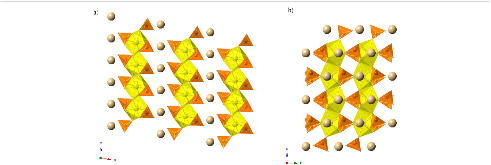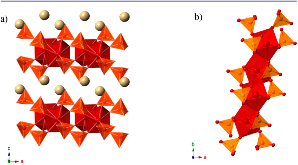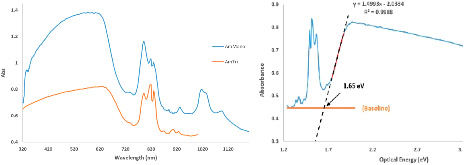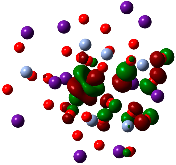|
Covalency in AnCp4 (An = Th–Cm): a comparison of molecular orbital, natural population and atoms-in-molecules analyses
|
journal
|
January 2010 |
|
Syntheses, Structures, and Spectroscopic Properties of Plutonium and Americium Phosphites and the Redetermination of the Ionic Radii of Pu(III) and Am(III)
|
journal
|
July 2012 |
|
Synthesis and Characterization of f -Element Iodate Architectures with Variable Dimensionality, α- and β-Am(IO 3 ) 3
|
journal
|
March 2006 |
|
From Yellow to Black: Dramatic Changes between Cerium(IV) and Plutonium(IV) Molybdates
|
journal
|
February 2013 |
|
Bis(cyclooctatetraenyl)neptunium(IV) and bis(cyclooctatetraenyl)plutonium(IV)
|
journal
|
August 1970 |
|
Transition metal iodates. V. Preparation and characterization of the smaller lanthanide iodates
|
journal
|
December 1974 |
|
Covalency hinders AnO 2 (H 2 O) + → AnO(OH) 2 + isomerisation (An = Pa–Pu)
|
journal
|
January 2016 |
|
Determining Relative f and d Orbital Contributions to M–Cl Covalency in MCl 6 2– (M = Ti, Zr, Hf, U) and UOCl 5 – Using Cl K-Edge X-ray Absorption Spectroscopy and Time-Dependent Density Functional Theory
|
journal
|
March 2012 |
|
Organometallic neptunium(III) complexes
|
journal
|
May 2016 |
|
Transition metal iodates. VI. Preparation and characterization of the larger lanthanide iodates
|
journal
|
June 1975 |
|
Identification of the Formal +2 Oxidation State of Plutonium: Synthesis and Characterization of {Pu II [C 5 H 3 (SiMe 3 ) 2 ] 3 } −
|
journal
|
March 2017 |
|
Uncovering f-element bonding differences and electronic structure in a series of 1 : 3 and 1 : 4 complexes with a diselenophosphinate ligand
|
journal
|
January 2013 |
|
Does covalency really increase across the 5f series? A comparison of molecular orbital, natural population, spin and electron density analyses of AnCp 3 (An = Th–Cm; Cp = η 5 -C 5 H 5 )
|
journal
|
January 2011 |
|
Emergence of comparable covalency in isostructural cerium( iv )– and uranium( iv )–carbon multiple bonds
|
journal
|
January 2016 |
|
Unprecedented Bidentate Coordination of the Uranyl Cation by the Chromate Anion in the Structure of [(CH3)2CHNH3]2[UO2(CrO4)2]
|
journal
|
December 2011 |
|
Covalency in f-element complexes
|
journal
|
January 2013 |
|
Does Covalency Increase or Decrease across the Actinide Series? Implications for Minor Actinide Partitioning
|
journal
|
June 2012 |
|
Incipient class II mixed valency in a plutonium solid-state compound
|
journal
|
May 2017 |
|
Emergence of californium as the second transitional element in the actinide series
|
journal
|
April 2015 |
|
Thorium(IV) chromate(VI) monohydrate
|
journal
|
November 2006 |
|
Synthesis and crystal structure of americium(V) dichromate, Cs3AmO2(Cr2O7)2·H2O
|
journal
|
January 2013 |
|
Surprising Coordination Geometry Differences in CeIV- and PuIV-Maltol Complexes
|
journal
|
May 2008 |
|
SHELXT – Integrated space-group and crystal-structure determination
|
journal
|
January 2015 |
|
On the Origin of Covalent Bonding in Heavy Actinides
|
journal
|
July 2017 |
|
Completing the Series of +2 Ions for the Lanthanide Elements: Synthesis of Molecular Complexes of Pr 2+ , Gd 2+ , Tb 2+ , and Lu 2+
|
journal
|
May 2013 |
|
Thermodynamic Study of the Complexation of Trivalent Actinide and Lanthanide Cations by ADPTZ, a Tridentate N-Donor Ligand
|
journal
|
March 2005 |
|
Electron-transfer and f-d absorption bands of some lanthanide and actinide complexes and the standard (II-III) oxidation potential for each member of the lanthanide and actinide series
|
journal
|
June 1973 |
|
Slave Boson Theory of Orbital Differentiation with Crystal Field Effects: Application to
|
journal
|
March 2017 |
|
Synthesis and Initial Evaluation for In Vivo Chelation of Pu(IV) of a Mixed Octadentate Spermine-Based Ligand Containing 4-Carbamoyl-3-hydroxy-1-methyl-2(1 H )-pyridinone and 6-Carbamoyl-1-hydroxy-2(1 H )-pyridinone
|
journal
|
August 2002 |
|
Local Structure in Americium and Californium Hexacyanoferrates - Comparison with Their Lanthanide Analogues
|
journal
|
February 2011 |
|
Highly Kinked Uranyl Chromate Nitrate Layers in the Crystal Structures of A[(UO2)(CrO4)(NO3)] (A = K, Rb)
|
journal
|
March 2012 |
|
Synthesis, crystallographic data, magnetic properties and vibrational study of the new series KLn(CrO4)4 (Ln = Eu, Gd, Tb)
|
journal
|
January 1990 |
|
Selective Extraction of Americium(III) over Europium(III) with the Pyridylpyrazole Based Tetradentate Ligands: Experimental and Theoretical Study
|
journal
|
October 2015 |
|
Synthesis and characterization of β-RbSc(CrO4)2
|
journal
|
July 1995 |
|
Spectroscopic Properties of Rare Earths
|
journal
|
September 1965 |
|
Superconductivity of Americium
|
journal
|
May 1978 |
|
The valence-fluctuating ground state of plutonium
|
journal
|
July 2015 |
|
Covalency-Driven Dimerization of Plutonium(IV) in a Hydroxamate Complex
|
journal
|
May 2016 |
|
Plutonium(IV) Sequestration: Structural and Thermodynamic Evaluation of the Extraordinarily Stable Cerium(IV) Hydroxypyridinonate Complexes1
|
journal
|
September 2000 |
|
Hydrothermal synthesis, structure, Raman spectroscopy, and self-irradiation studies of 248Cm(IO3)3
|
journal
|
December 2004 |
|
Isopropylammonium Layered Uranyl Chromates: Syntheses and Crystal Structures of [(CH3)2CHNH3]3[(UO2)3(CrO4)2O(OH)3] and[(CH3)2CHNH3]2[(UO2)2(CrO4)3(H2O)]
|
journal
|
March 2012 |
|
Structural Periodicity in Plutonium(IV) Sulfates
|
journal
|
June 2011 |
|
Hydrothermal Synthesis of Rare Earth Iodates from the Corresponding Periodates: II1). Synthesis and Structures of Ln(IO3)3 (Ln = Pr, Nd, Sm, Eu, Gd, Tb, Ho, Er) and Ln(IO3)3· 2H2O (Ln = Eu, Gd, Dy, Er, Tm, Yb)
|
journal
|
March 2004 |
|
Comparisons of Pu(IV) and Ce(IV) Diphosphonates
|
journal
|
April 2010 |
|
A study of ionic conductivity in double rare-earth chromates
|
journal
|
September 1993 |
|
Crystal chemistry of thorium nitrates and chromates
|
journal
|
July 2010 |
|
Valence basis sets for relativistic energy-consistent small-core actinide pseudopotentials
|
journal
|
January 2003 |
|
Transition metal iodates. VII. Crystallographic and nonlinear optic survey of the 4f-iodates
|
journal
|
January 1976 |
|
Relevance of Kondo physics for the temperature dependence of the bulk modulus in plutonium
|
journal
|
January 2017 |
|
Segmented contraction scheme for small-core actinide pseudopotential basis sets
|
journal
|
March 2004 |
|
First Structural Determination of a Trivalent Californium Compound with Oxygen Coordination
|
journal
|
January 2006 |
|
Measurement of the first ionization potential of lawrencium, element 103
|
journal
|
April 2015 |
|
Exchange and correlation in atoms, molecules, and solids by the spin-density-functional formalism
|
journal
|
May 1976 |
|
Hydrothermal Synthesis of Rare Earth Iodates from the Corresponding Periodates: Structures of Sc(IO3)3, Y(IO3)3 · 2 H2O, La(IO3)3 · 1/2 H2O and Lu(IO3)3 · 2 H2O
|
journal
|
January 2002 |
|
Crystal growth, structure, and properties of KLa(CrO 4 ) 2
|
journal
|
January 1988 |
|
Quantifying the σ and π Interactions between U(V) f Orbitals and Halide, Alkyl, Alkoxide, Amide and Ketimide Ligands
|
journal
|
July 2013 |
|
New Insights into Formation of Trivalent Actinides Complexes with DTPA
|
journal
|
November 2012 |
|
First-principles calculations of the electronic structure and spectra of strongly correlated systems: dynamical mean-field theory
|
journal
|
September 1997 |
|
Structural, Spectroscopic, and Theoretical Comparison of Traditional vs Recently Discovered Ln 2+ Ions in the [K(2.2.2-cryptand)][(C 5 H 4 SiMe 3 ) 3 Ln] Complexes: The Variable Nature of Dy 2+ and Nd 2+
|
journal
|
December 2014 |
|
Characterization of berkelium(III) dipicolinate and borate compounds in solution and the solid state
|
journal
|
August 2016 |
|
On rubidium lanthanide double chromates
|
journal
|
January 1993 |
|
Expanding the Chemistry of Molecular U 2+ Complexes: Synthesis, Characterization, and Reactivity of the {[C 5 H 3 (SiMe 3 ) 2 ] 3 U} − Anion
|
journal
|
December 2015 |
|
Bonding Changes in Plutonium(III) and Americium(III) Borates
|
journal
|
August 2011 |
|
Paramagnetism of Aqueous Actinide Cations. Part I: Perchloric Acid Media
|
journal
|
February 2014 |
|
Monomers, Dimers, and Helices: Complexities of Cerium and Plutonium Phenanthrolinecarboxylates
|
journal
|
April 2016 |
|
The accuracy of the pseudopotential approximation: non-frozen-core effects for spectroscopic constants of alkali fluorides XF (X = K, Rb, Cs)
|
journal
|
June 1996 |
|
Crystal growth, IR and Raman spectra, thermal decomposition and magnetic properties of KLn(CrO4)2 (Ln ≡ Pr, Nd, Sm)
|
journal
|
May 1988 |
|
The First Sodium Uranyl Chromate, Na4[(UO2)(CrO4)3]: Synthesis and Crystal Structure Determination
|
journal
|
October 2003 |
|
Principle of Maximum Entanglement Entropy and Local Physics of Strongly Correlated Materials
|
journal
|
July 2014 |
|
Antiferromagnetism and d -wave superconductivity in cuprates: A cluster dynamical mean-field theory
|
journal
|
October 2000 |
|
Bonding Trends Traversing the Tetravalent Actinide Series: Synthesis, Structural, and Computational Analysis of An IV ( Ar acnac) 4 Complexes (An = Th, U, Np, Pu; Ar acnac = Ar N C(Ph)CHC(Ph) O ; Ar = 3,5- t Bu 2 C 6 H 3 )
|
journal
|
July 2012 |
|
Synthesis, Structure, and Spectroscopic Properties of Am(IO 3 ) 3 and the Photoluminescence Behavior of Cm(IO 3 ) 3
|
journal
|
August 2005 |
|
Structure validation in chemical crystallography
|
journal
|
January 2009 |
|
Directed evolution of the periodic table: probing the electronic structure of late actinides
|
journal
|
January 2017 |
|
Evaluation of f-element borate chemistry
|
journal
|
September 2016 |
|
Structural properties of plutonium from first-principles theory
|
journal
|
January 1997 |
|
Periodic Trends in Lanthanide and Actinide Phosphonates: Discontinuity between Plutonium and Americium
|
journal
|
June 2012 |
|
Unusual structure, bonding and properties in a californium borate
|
journal
|
March 2014 |
|
Crystal growth and crystal structure of KTb(CrO4)2
|
journal
|
March 1990 |
|
Formation of a Eu( iii ) borate solid species from a weak Eu( iii ) borate complex in aqueous solution
|
journal
|
January 2014 |
|
Toward reliable density functional methods without adjustable parameters: The PBE0 model
|
journal
|
April 1999 |
|
New evidence for 5f covalency in actinocenes determined from carbon K-edge XAS and electronic structure theory
|
journal
|
January 2014 |
|
Incorporation of Technetium into Spinel Ferrites
|
journal
|
November 2016 |
|
Demonstration of the LUCA process for the separation of americium(III) from curium(III), californium(III), and lanthanides(III) in acidic solution using a synergistic mixture of bis(chlorophenyl)dithiophosphinic acid and tris(2-ethylhexyl)phosphate
|
journal
|
January 2010 |
|
Experimental and Theoretical Comparison of Actinide and Lanthanide Bonding in M[N(EPR 2 ) 2 ] 3 Complexes (M = U, Pu, La, Ce; E = S, Se, Te; R = Ph, i Pr, H)
|
journal
|
January 2008 |
|
Transition metal iodates. II. Crystallographic, magnetic, and nonlinear optic survey of the 3d iodates
|
journal
|
June 1973 |
|
Divalent and trivalent gas-phase coordination complexes of californium: evaluating the stability of Cf( ii )
|
journal
|
January 2016 |
|
Hydroxypyridinonate Complex Stability of Group (IV) Metals and Tetravalent f-Block Elements: The Key to the Next Generation of Chelating Agents for Radiopharmaceuticals
|
journal
|
March 2015 |
|
Dynamical mean-field theory of strongly correlated fermion systems and the limit of infinite dimensions
|
journal
|
January 1996 |
|
New iodate materials as potential laser matrices. Preparation and characterisation of α-M(IO3)3 (M=Y, Dy) and β-M(IO3)3 (M=Y, Ce, Pr, Nd, Eu, Gd, Tb, Dy, Ho, Er). Structural evolution as a function of the Ln3+ cationic radius
|
journal
|
June 2007 |
|
Spontaneous Partitioning of Californium from Curium: Curious Cases from the Crystallization of Curium Coordination Complexes
|
journal
|
November 2015 |
|
Polyhedral Structures with an Odd Number of Vertices: Nine-Coordinate Metal Compounds
|
journal
|
January 2008 |
|
Generalized phase diagram for the rare-earth elements: Calculations and correlations of bulk properties
|
journal
|
April 1975 |
|
Variational versus Perturbational Treatment of Spin–Orbit Coupling in Relativistic Density Functional Calculations of Electronic g Factors: Effects from Spin-Polarization and Exact Exchange
|
journal
|
December 2012 |
|
Spectrum analysis of U 3+ :LaCl 3
|
journal
|
May 1980 |
|
A review of the demonstration of innovative solvent extraction processes for the recovery of trivalent minor actinides from PUREX raffinate
|
journal
|
August 2012 |
|
Chelation and stabilization of berkelium in oxidation state +IV
|
journal
|
April 2017 |
|
High-Resolution Solid-State Oxygen-17 NMR of Actinide-Bearing Compounds: An Insight into the 5f Chemistry
|
journal
|
June 2014 |
|
Comparison of Covalency in the Complexes of Trivalent Actinide and Lanthanide Cations
|
journal
|
August 2002 |
|
Using Phosphonates to Probe Structural Differences Between Transuranium Elements and Their Proposed Surrogates
|
journal
|
March 2010 |













